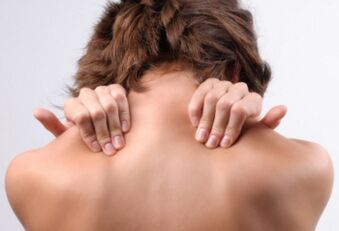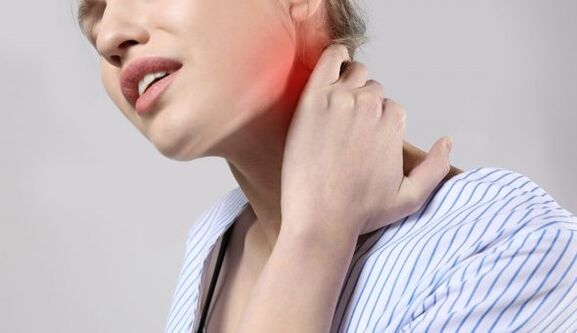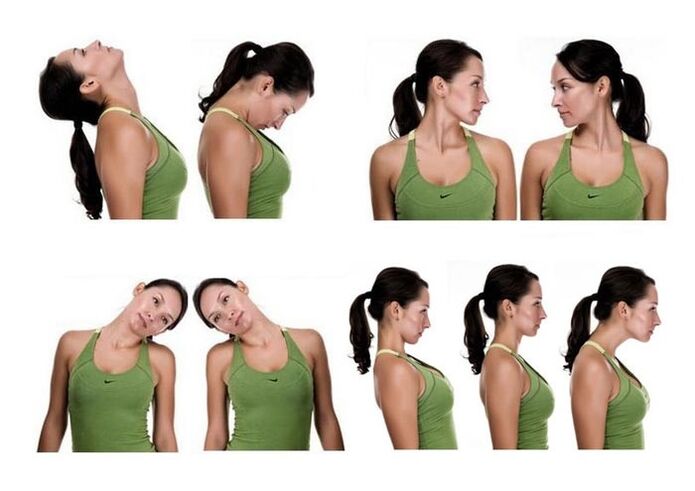
Most modern people have never heard of osteochondrosis. Most of them have experienced the symptoms of this disease several times. Widespread disease can be caused by sitting at a computer for a long time, a passive lifestyle, poor nutrition and so on. associated with. Osteochondrosis of the cervical spine is manifested by pain, muscle weakness, limited mobility and a number of other symptoms.
Do not ignore the symptoms of osteochondrosis, because the sooner you start treatment, the sooner you will get rid of the disease. In the initial stages, conservative therapy is carried out: medication, exercise therapy, physiotherapy, massage, etc. . Surgery is prescribed when complications appear and when the bone-cartilage structure is destroyed.
What is this
Osteochondrosis of the neck is a pathology that occurs only in humans. Animals do not suffer from this. This is due to the vertical position of the spine. In this case, the vertebrae squeeze each other, which leads to the gradual destruction of the intervertebral discs.
The cervical region consists of 7 vertebrae separated by discs. This segment of the spine is quite mobile, so it is one of the most sensitive areas of the spine. The weakest link in the cervical spine is the intervertebral disc, which primarily reflects degenerative-dystrophic changes.
The prevalence of cervical osteochondrosis is also explained by a weak muscle corset in the neck. In addition, the small vertebrae are located in this area, they have a different structure and fit very closely together. Therefore, even a small load on the neck can cause them to move, as well as constrict blood vessels and nerve branches. Dangerous complications occur when the spinal artery inside the spine is constricted in this area.
Osteochondrosis of the cervical spine (CS) is threatened by protrusions (displacement of the pulp nucleus without damaging the outer shell) and a disc herniation. These formations compress nerve bundles and blood vessels.
Due to degenerative changes in the intervertebral discs, the likelihood of bone growths (osteophytes) in the areas of the vertebral joints increases. For this reason, the intervertebral canal narrows and neurovascular formations are compressed.
Reference. According to medical statistics, people over the age of 35 suffer more from cervical osteochondrosis. Although there is now a rejuvenation of the pathology, which often develops in patients over 20 years of age. This is mainly due to a sedentary lifestyle and poor nutrition.
Doctors distinguished 4 stages of pathology:
- Grade 1 - The cartilaginous lining between the vertebrae begins to collapse. At this stage, the symptoms of the disease disappear. Unfortunately, patients do not feel them.
- Grade 2 - under the pressure of the vertebrae, the height of the disc decreases, the integrity of its outer shell is violated. Protrusions may appear at this stage. Pain is visible, neck mobility is limited, facial sensitivity may be impaired.
- Grade 3 - protrusions turn into hernias that constrict blood vessels and muscles. In addition to the pain syndrome, there is pain in the back of the head, dizziness.
- Grade 4 - Osteophytes are formed that stabilize the vertebrae but compress the nerve fibers. The pain does not pass, stiffness occurs, the neighboring vertebra is damaged, neurological symptoms appear.
It is important to start treatment in stages 1-2 to prevent serious complications that can only be corrected surgically.
Reasons
Osteochondrosis SHOP is a complex and lengthy process that can occur under the influence of many adverse factors.
For example, in the elderly, the disease is associated with age-related changes in the body. Then degenerative-dystrophic changes occur as a result of disruption of local blood circulation, metabolic processes, weakening of immunity.
However, doctors have identified the main causes of cervical osteochondrosis:
- Poor posture.
- Curvature of the spine.
- Cervical segment injuries.
- Excess weight.
- Tiring physical work.
- Sitting at the computer for a long time.
- Passive lifestyle.
- Disorders of metabolic processes.
- Frequent hypothermia of the neck.
- Improper arrangement of the bed (very soft mattress, high pillow).
- Frequent stress, chronic fatigue.
- Congenital pathologies of the SHOP structure.
- Autoimmune diseases that cause cartilage degeneration.
- Infections.
- Features of body parts such as very long or short necks.
Under the influence of these factors, intervertebral structures, bone tissue begins to collapse, nerve connections and blood vessels are damaged.
Symptoms
The clinical picture of cervical spine osteochondrosis (OSHOP) is different. Therefore, it is difficult for patients to understand what happened to them. Early manifestations of the disease are associated with overwork. They rush to the doctor after the appearance of certain symptoms, but in this case, irreversible changes are already present and it will no longer be possible to restore the structure of the cervical spine.

The main symptoms of osteochondrosis of the cervical spine:
- Pain in the neck and shoulders.
- Weakening of the muscles surrounding the affected segment of the spine.
- Excessive sweating.
- Sensitivity disorders of the upper extremities.
- Movement coordination disorders.
- Cephalalgia (headache).
- Vertigo (dizziness).
- Hearing and vision disorders.
- Rising blood pressure, etc.
The nature of headaches in osteochondrosis is different: paroxysmal, persistent, pulsating, dull. This symptom is manifested by spasm of cerebral vessels, compression of nerve bundles of the cervical spine and increased intracranial pressure.
With OSHOP, the pain is not always visible in the cervical segment, but can spread to the shoulders and arms. Anxiety can be caused by sleep, sudden movements, neck tension, such as coughing or sneezing.
With SHOP osteochondrosis, pressure increases are observed depending on the time of day, persistent hypertension is not characteristic of the pathology. The following symptoms are usually observed with an increase in pressure: cephalalgia, pain in the hands, numbness of the cervical-collar area. Decreased blood pressure is often observed after prolonged restless posture due to nerve or muscle tension.
Cervical osteochondrosis syndromes
There are several syndromes (typical cases with characteristic symptoms) in OSHOP. Their manifestation depends on which nerve branches and vessels are damaged.
Cervical osteochondrosis syndromes:
- Vertebral artery - occurs as a result of constriction or irritation of the artery that feeds the brain. Then the patient has hearing loss, vision, dizziness, hypotension, migraine, etc.
- Heart - develops when the nerve connections that innervate the diaphragm or chest muscle are compressed. Then there is burning pain in the chest, shortness of breath, weakness, increased heart rate.
- Hypertensive - occurs as a result of constriction of blood vessels, so blood flow is disrupted from the beginning. Then the intracranial pressure rises, the patient suffers from cephalalgia, nausea and vomiting.
- Cervical migraine - occurs due to compression of the nerves surrounding the vertebral artery. Then there is a painful migraine-like pain in the back of the head. The attack lasts about 10 hours and is often accompanied by an eruption of vomiting.
- It is the most common symptom complex in radicular OSHOP. This is caused by compression of one of the nerve ligaments in the vertebrae of the cervical segment. If the permeability of 1 - 2 roots of the cervical vertebra is impaired, sensitivity is impaired or pain appears in the back of the head. If 3 pairs are damaged, the tongue becomes numb, the area behind the ears becomes difficult for a person to chew. Inflammation of 4 pairs of roots is accompanied by pain in the clavicle, hiccups, difficulty swallowing. If the conduction of 5 to 8 pairs of nerves is impaired, then the patient has difficulty moving his arms.
Reference. Often, cervical lumbar osteochondrosis manifests itself in several symptom complexes at once, and then the diagnosis is difficult. Therefore, you should not understand this yourself, it is better to contact a specialist.
Diagnosis
If you do not know what to do when suspicious symptoms appear, it is better to contact a therapist immediately. If necessary, the doctor will refer you to an orthopedist, vertebrologist, neurologist.
The following instrumental studies are used in the diagnostic search:
- Radiography.
- Computed tomography or magnetic resonance imaging.
- Electroneuromyography.
All of the above studies provide some information about the cervical spine. For example, X-ray, CT, MRI are used to detect pathological changes in the structure of the spine. Electromyography allows you to assess the condition of the nerve endings.
Accumulation of calcium salts with the help of radiography in various projections, reduction of the height of the cartilaginous spaces between the vertebrae, deformation of the CS, the presence of bone protrusions, etc. .
Treatment
OSHOP therapy should be comprehensive. The decision on the choice of technique is made by the doctor, taking into account the stage, form of the disease and the severity of symptoms.
Treatment of osteochondrosis of the cervical spine is long and complicated. Especially in the case of an elderly patient, it will not be possible to completely cure the pathology. However, it is quite possible to stop degenerative-dystrophic disorders in the cervical segment at any stage.
In the early stages of the disease, conservative methods are used: medication, therapeutic gymnastics, physiotherapy procedures, massage, orthopedic devices. Most of the above methods can be used at home.
Surgery may be required in stages 3 to 4, accompanied by destruction of not only cartilage but also vertebral organs.
The following medications will help relieve pain, inflammation, relax tense muscles, and improve the condition of cartilage tissue:
- Painkillers. If the pain is severe, you can help yourself by taking an analgesic pill. For the same purpose, NSAIDs are used to fight not only pain but also inflammation.
- Steroids stop inflammation and pain. For this purpose, drugs based on glucocorticoids are used in the form of tablets or ointments.
- The muscle relaxant helps to relax the spasmodic muscles around the affected area. For this purpose, solutions for parenteral administration based on glycerin or benzimidazole are used. They normalize muscle tone and relieve pain.
- Antispasmodics help fight pain and muscle cramps.
- Vitamins accelerate the recovery of the nervous system. For this purpose, drugs are taken on the basis of elements of groups B, A, C, D, E. Vitamin-mineral complexes are quite effective.
Reference. If the pain syndrome is very severe and oral analgesics do not help, the doctor may prescribe a therapeutic block. With the use of anesthetic or steroid solutions, injections are placed directly into the center of the pathology. This procedure should only be performed by an experienced professional.
Creams, gels, ointments with anti-inflammatory, warming and analgesic effects are used as part of complex therapy.
Therapeutic exercises are prescribed to alleviate the condition of patients and improve their physical fitness. Exercise helps strengthen the muscles around the neck, improves metabolic processes, speeds up blood circulation and relieves stress on a weakened spine.
Gymnastics is especially popular at OSHOP, usually with the use of special simulators in the gym. But if you want, you can train at home.

Exercise therapy complex for cervical osteochondrosis:
- Bend your head smoothly over your shoulder, lock for 30 seconds, then repeat the movement in the other direction.
- Tilt your head forward and try to touch your chin to your chest, then lift up and move forward slightly.
- Lower your head slightly, turn to the right, and then to the left shoulder.
- Squeeze your left shoulder with your right hand, lift your elbow slightly. Then turn your head to the right, lie down, feel the muscle tension.
- This exercise is performed as a third, just turn your head, raise your arms above your head and tie them together.
- Put your hands on your knees, spread them apart, try to join the shoulder blades, and at the same time lift your chin. So you will work the thoracic region.
- Get up, lower your arms, stretch your neck forward, try to touch your chin to your shoulder.
Before exercising, you should take a joint warm-up and shower to relax your muscles. Lie down after completing the complex.
With the help of physiotherapy you can treat osteochondrosis of the neck:
- UHF.
- Laser therapy.
- Magnetotherapy.
- Electrophoresis with drugs, etc.
Magnetotherapy relieves inflammation and pain. UHF and laser treatment speed up the metabolism in the affected area, helping to eliminate swelling. Thanks to electrophoresis, the drug penetrates the site of inflammation through the skin and has an immediate effect there.
With the help of massage, muscle tone is normalized, blood flow to the damaged area is accelerated, and tissue trophism is improved. The development of degenerative-dystrophic processes in the cervical spine usually stops after completing a course of 10 procedures.
At home, you can use a needle applicator - this is a plastic device with a large number of spikes. You should lie on the device or apply it to the affected area. The applicator helps relieve pain, relaxes muscles, improves blood circulation and movement.
Shants collar is used in case of severe pain. This orthopedic device straightens the neck, reduces the load on the vertebrae and relieves pain.
With complex treatment, the patient can get rid of degenerative disc disease of the neck forever. However, this is possible if the disease is detected in stage 1. In other cases, complex measures will help stop the development of pathology.
Chondrosis of the cervical spine
Many people believe that chondrosis and osteochondrosis are a disease. But this idea is wrong. In the first disease, only the cartilage of the vertebrae is damaged, and in the second, degenerative changes spread to the bone tissue. That is, chondrosis is the first stage of osteochondrosis.
Chondrosis of the cervical spine develops when the metabolic processes of the intervertebral disc are disrupted. Then the collagen fibers are replaced by useless fibrous tissue, hyaline cartilage calcifies and becomes less elastic. Its height decreases, so the function of the vertebrae is impaired.
The causes of chondrosis and osteochondrosis are no different.
Cervical chondrosis has the following symptoms:
- Rapid fatigue of the muscles surrounding the store.
- Poor posture.
- Recurrent discomfort or mild pain in the affected area.
- Limited neck mobility.
As a rule, patients do not feel the symptoms of chondrosis. The disease is detected by chance, during an X-ray or MRI.
Treatment of chondrosis
The treatment plan for cervical chondrosis is slightly different from the treatment tactics for osteochondrosis. In the first disease, doctors prescribe NSAIDs and chondroprotectors. In addition, the patient should avoid excessive physical exertion or prolonged sitting. It is recommended to do therapeutic exercises, eat right, give up bad habits.
Additional treatments include massage and manual therapy. In addition, physiotherapy procedures are indicated, such as electrophoresis, ultraviolet radiation, amplipulse therapy, diadynamic therapy, balneotherapy, mud therapy. Acupuncture (acupuncture) has proven effective in the treatment of chondrosis.
Reviews
In most cases, patients are able to recover from the symptoms of cervical osteochondrosis for a while, after which the disease returns. This is usually due to the patient's late visit to the doctor or failure to follow the doctor's recommendations during treatment. However, there are those who are able to treat OSHOP and no longer experience its symptoms.
- "I was diagnosed with stage 2 osteochondrosis of the neck. The doctors prescribed anti-inflammatory pills and injections. After the pain started, I started massaging, doing special exercises and using a medicated ointment. After the course of treatment, I felt significant relief. But after 3 months, neck pain. It showed itself again. Therefore, it was necessary to start the course from the beginning. "
- "I have been living with osteochondrosis of the neck for a long time. From time to time I visit a chiropractor who determines the vertebrae. But most physiotherapy exercises help me. The doctor offered very effective exercises that I try to do every day. But as soon as I miss a few classes, the pain starts again. ".
- "Osteochondrosis of the cervix is treated enough in the early stages. It happened to me. First, doctors prescribed anti-inflammatory therapy to relieve pain and inflammation. Then the treatment was completed with gymnastics, massage, acupuncture. In addition, I visited the pool to take vitamins and eat properly. I had to change my life completely to forget the pain forever. No day goes by without special training, but the positive thing is that nothing hurts me and my physical condition has improved. I do not feel back pain for a long time and continue to lead a healthy lifestyle. "
The main results
Osteochondrosis of the cervical spine is an insidious disease with various symptoms. The patient does not always understand what happened to him. When he sees severe pain, he rushes to the doctor, but this sign indicates the presence of degenerative-dystrophic changes in the cervical segment. In this case, it will not be possible to restore the condition of the spine. Then treatment is given to help stop the development of pathology and avoid serious consequences. Osteochondrosis therapy is a complex and lengthy process that requires patience and organization. After relieving pain and inflammation, the patient should receive regular exercise therapy, massage, physiotherapy procedures, use orthopedic devices, eat properly, and give up bad habits. It is important to lead a healthy lifestyle, maintain moderate physical activity, control weight and control posture. Only in this case, you will be able to stop the pathology and live a full life.

















































